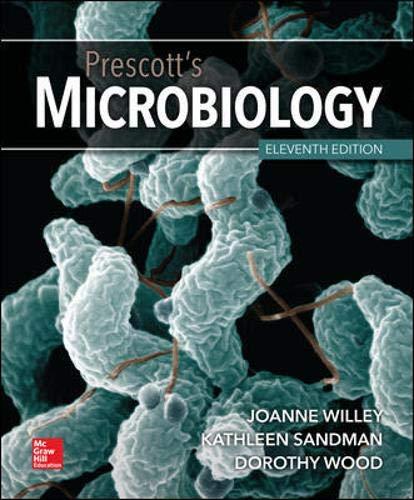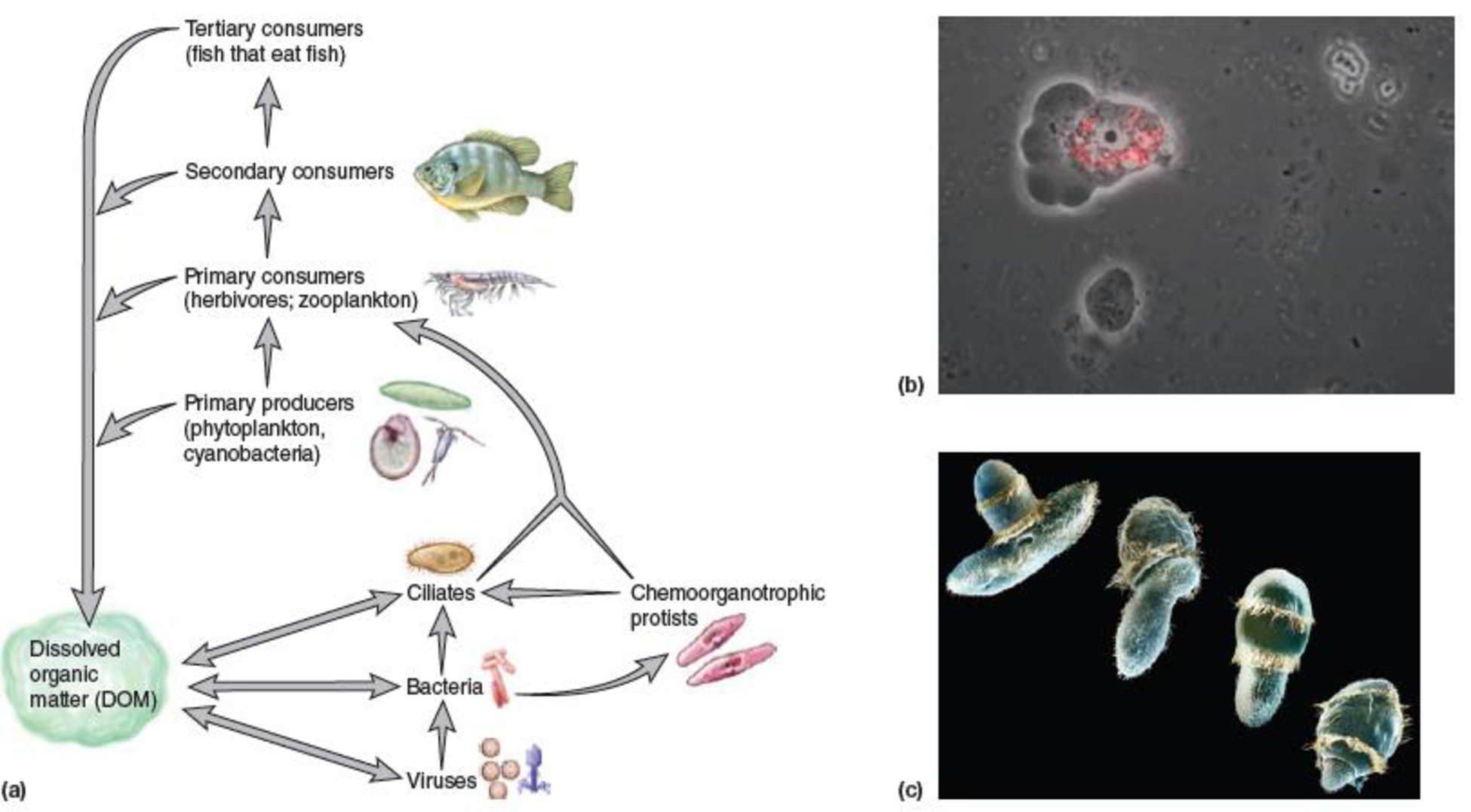
Concept explainers
It is well known that bacterivory (the consumption of bacteria) supports the growth of marine protists that lack plastids. However, measurements of bacterivory among plastid-containing planktonic algae are surprising in showing that small (<5 μm) algae carry out between about 40 to 95% of the bacterivory in the photic zone of the North Atlantic. Discuss how this level of mixotrophy impacts the concept of the microbial loop (figure 30.6).

Figure 30.6 The Microbial Loop. (a) Microorganisms play vital roles in ecosystems as primary producers, decomposers, and primary consumers. All organisms contribute to a common pool of dissolved organic matter (DOM) that is consumed by microbes. Viruses contribute DOM by lysing their hosts, and bacterial and archaeal cells are consumed by protists, which also consume other protists. These microbes are then consumed by herbivores that often select food items by size, thereby ingesting both heterotrophic and autotrophic microbes. Thus nutrient cycling is a complex system driven in large part by microbes. (b) Protists consume bacteria; in this case, a naked amoeba is consuming the cyanobacterium Synechococcus sp. which fluoresces red. (c) Protists consume protists; here, the ciliate Didinium sp. (rounded organism with two rows of cilia) is preying upon another ciliate, Paramecium sp.
Want to see the full answer?
Check out a sample textbook solution
Chapter 30 Solutions
Prescott's Microbiology
- Microtaxonomy (Species and Speciation) Colletotrichum gloeosporioides is a fungus that causes mango anthracnose. It's a devastating disease being avoided by mango farmers. For example, in the island province of Guimaras, Philippines, one cannot bring mango into the island to avoid contamination of the mango plantations. Guimaras produces the sweetest mango in the world. One challenge in the control of mango anthracnose is that C. gloeosporioides is a species complex. What is a complex and how do we provide clear delineation (if we can) among these closely related species?arrow_forwardIn the early 1930s, G. F. Gause carried out a series of experiments using two species of ciliated protists (Paramecium), which are single-celled eukaryotic protozoans. The protists were cultured together and separately, with the bacteria being the single food source. The results are shown in the figure below. (a) Based on figure, identify and explain the interaction that is taking place between P. caudatum and P. aurelia. (b) Clam shrimp, a natural predator to P. caudatum, is introduced to the culture containing both P. caudatum and P. aurelia after 24 days. Predict the impact that the clam shrimp will have on the culture and the populations. Justify your prediction.arrow_forwardThe amoeba Pelomyxa palustris is a single-celled eukaryote with nomitochondria, but it contains symbiotic bacteria that can live in thepresence of oxygen. How does this observation support theendosymbiont theory?arrow_forward
- Describe the two most common symbiotic relationships algae are found in.arrow_forwardComplete Table 1by doubling the number of bacteria (Clostridium sp.) and diatoms (Chaetoceros sp.) every 30 minutes and 60 minutes, respectively, and by writing the log10 of this number in the appropriate columns with the results , Draw a graph showing the growth (N) of the populations of both species from time = 0 (also written as t0) to time = 310 (t310) minutes. Draw both populations on the same graph. NB: It will be necessary to plot Chaetoceros sp. on a second y-axis. Label the axes and provide a suitable legends.arrow_forward* 0O 100 v Ao you would use to identify this species (what features would you use personally to ID). ^タヘ三 臣ヘ= 5. View the protists blood parasites (Trypanosoma cruzi, Trypanosoma brucei, and Plasmodium vivax). Which of these species is more likely to cause the most human issues (in terms of number of people with the disease)? What is one of the most likely ways to keep from being infected by any of these blood parasites? Explain. 6. What are slime molds? 7. Identify the organisms below. Next to each name you ID the organism as, give 2 features that helped you come to that determination. Name of organism: a. Features used to ID: 771 words English (U.S.) Text Predictions: On DEOL 8. ca上門后 MacBook Air 71 64 000 F4 F5 F6 F8 F2 F3 23 2$ 5. 6. 4. R.arrow_forward
- DNA sequence data for a diplomonad, a euglenid, a plant, and an unidentified protist suggest that the unidentified species is most closely related to the diplomonad. Further studies reveal that the unknown species has fully functional mitochondria. Based on these data, at what point on the phylogenetic tree in Figure 1 did the mystery protist’s lineage probably diverge from other eukaryote lineages? Explain.arrow_forwardWhich of the following is NOT one of the roles of algae in nature? O a. Petroleum is the fossil remains of planktonic algae. O b. Algae are the primary producers in the aquatic food chain. O c. Planktonic algae produces carbon dioxide as by-product of their photosynthesis. O d. Unicellular algae are symbionts of Tridacna.arrow_forwardEukaryotic cells can be detected at latest mid-way through the Proterozoic, and multicellular eukaryotes not long after – but there is a curious lag before the radiation of multicellular eukaryotic groups. We discussed two possible reasons for this. Explain both. Why might an early arrival of lichens on land explain aspects of both of those possibilities?arrow_forward
- Scientists examined the interactions between bacteria and two species of protozoa, Uronema sp. and Euplotes sp., found in the bays and inlets of coastal California. An experiment was designed that modeled the ecosystem and measured the amount of bacteria and carbon that were ingested by the protozoal species, as shown in the data table. Bacteria with labeled glucose were incubated with these two species of protozoa. The number of bacteria, carbon ingested, and carbon exuded from the protozoa were then measured. Which of the following explains how the difference between ingested and exuded carbon relates to the energy in the aquatic ecosystem? Protozoa Bacteria Ingested (x107 l‒1h‒1) Bacterial Carbon Ingested (ngC l‒1h‒1) Exuded Bacterial Carbon (ngC l‒1h‒1) Uronema sp. 172.20 34,460 3,067 Euplotes sp. 50.82 10,170 305 The protozoa hydrolyzed the ingested carbon, resulting in an increase in energy within the ecosystem. The protozoa decomposed…arrow_forwardDiscuss the life cycle of the brown algae Laminaria, which shows the alternating of generations.arrow_forwardI don't understand this practice bio question: Despite the fact that modern taxonomists have abandoned the Kingdom Protista, the term "protist" persists in the biological literature. Explain the current meaning of the term protist and give several specific examples.arrow_forward
 Biology Today and Tomorrow without Physiology (Mi...BiologyISBN:9781305117396Author:Cecie Starr, Christine Evers, Lisa StarrPublisher:Cengage Learning
Biology Today and Tomorrow without Physiology (Mi...BiologyISBN:9781305117396Author:Cecie Starr, Christine Evers, Lisa StarrPublisher:Cengage Learning Biology: The Dynamic Science (MindTap Course List)BiologyISBN:9781305389892Author:Peter J. Russell, Paul E. Hertz, Beverly McMillanPublisher:Cengage Learning
Biology: The Dynamic Science (MindTap Course List)BiologyISBN:9781305389892Author:Peter J. Russell, Paul E. Hertz, Beverly McMillanPublisher:Cengage Learning

